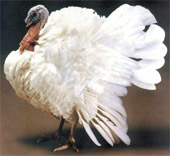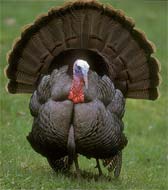This news item expired on Saturday, November 30, 2013 so the information below could be outdated or incorrect.
 The juicy turkey that will grace many dining room tables this Thanksgiving is not the bird some may imagine it to be. The domestic turkey, unlike its wild cousin, is a succulent example of modern efficiency in agricultural production.
The juicy turkey that will grace many dining room tables this Thanksgiving is not the bird some may imagine it to be. The domestic turkey, unlike its wild cousin, is a succulent example of modern efficiency in agricultural production.
The bird many envision when they think turkey is really a wild bird – the one seen in Thanksgiving displays with Pilgrims, Indians and women in bonnets. The National Wild Turkey Federation (NWTF) says the noble wild turkey is a far gobble from the plump, domesticated bird raised commercially.
 "As Thanksgiving nears each year we get a lot of questions about the difference between the two," says Jonathan Harling, public relations director with the South Carolina based NWTF.
"As Thanksgiving nears each year we get a lot of questions about the difference between the two," says Jonathan Harling, public relations director with the South Carolina based NWTF.
All turkeys were once wild and the federation credits North American Indians with the first breeding and taming turkeys as domesticated birds.
"The domestic turkey is a wild turkey that became dependent on man to feed it," Harling says.
One North Carolina family that feeds a whole lot of white-feathered domestic turkeys – one million a year – is the Talley family of Talley Farms in Stanly County. While David Talley serves on the Stanly County Farm Bureau Board of Directors, his father, Wendell, is the head of their operation.
"We've been raising turkeys for 44 years," Wendell Talley says. "Today's turkey is lower in fat, has a much larger breast and is higher in nutrition than those raised in the 1960s."
Modern agriculture has found ways to successfully grow the domestic bird population, but wild turkeys suffered lost habitat and severely declined in numbers until the 1970s.
"Only 30,000 wild turkeys were thought to exist in the entire United States when the federation began in 1973," Harling explains.
Through conservation efforts in North Carolina and throughout the country, he says the national population of wild turkeys today has grown to nearly 7 million birds.
Source: NC Farm Bureau Magazine